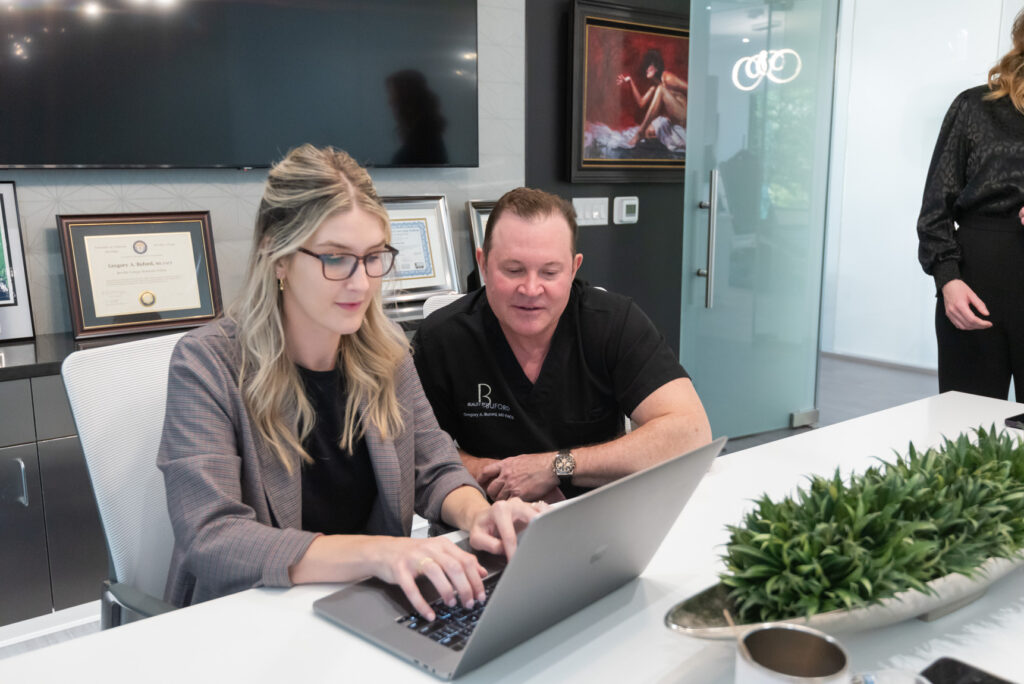Although the BEAUTY by BUFORD team can’t imagine a world before tummy tucks, this procedure has only been around for a short while in the grand scheme of things. The fascinating history of the tummy tuck goes all the way back to the 1800s, and we’re here to catch you up to speed from the early years to today.
In the Beginning…
Long before it became one of the most popular procedures at BEAUTY by BUFORD, the tummy tuck had humble beginnings. As early as the 1800s, doctors began using similar procedures to heal wounds in the abdomen, and they found that removing excess skin from the abdominal area was the best way to treat umbilical hernias. Unfortunately, it had an unfortunate side effect: they also removed the belly button.
Despite this unsightly change, however, doctors began to take notice of a more positive aspect – that the surgery immediately improved the appearance and shape of their patients’ abdomens. It’s no surprise that it didn’t take long before doctors realized the potential impact of this surgery on aesthetic medicine (as long as they could solve the belly button issue, of course).
Advancing Techniques
Even though the questions about belly button removal and the appearance of the scars had not yet been addressed, abdominoplasties performed by early surgeons in America began to gain popularity. In fact, the first abdominoplasty was completed in 1899, and by the early 1900s, surgeons had set their minds to finding new methods of performing the surgery without the disadvantages.
The French were the first to discover a method to preserve the belly button and maintain a natural appearance post-op. French surgeons nixed the horizontal incision technique that cut through abdominal tissue and opted for vertical incisions that saved it instead.
Then, in the years following World War I, doctors redoubled their focus on the second problem with early tummy tucks: scarring. During the war, doctors were forced to improve their procedures for a variety of reasons, and the resulting surgical techniques created less visible scars as surgeons learned to preserve the abdominal structure while healing wounds and caring for patients.
From War Wounds to Weight Loss
Although doctors knew for many years that abdominoplasties could reduce waistlines and enhance patients’ looks, the procedure wasn’t widespread until the 1970s and 1980s. Surgeons switched from treating war wounds to weight loss, using their newly-improved techniques to achieve better post-op results.
The natural appearance of these procedures attracted many Americans to seek treatment. When liposuction became available in 1974, they began combining tummy tucks with this new method for better results, and it quickly became one of America’s most popular aesthetic procedures.
Tummy Tucks of Today
Cosmetic surgery is improving every year, and that includes the modern tummy tuck. Abdominoplasties of the 21st century are widely used to tighten and tone the stomach and boost confidence, and they can be tailored to meet each patient’s specific needs, making them more effective than ever.
Plastic surgeons have drastically improved the recovery time for tummy tuck procedures by introducing non-narcotic long-acting pain relief, compression advances, and lymphatic massages that can help reduce fluid buildup.
Dr. Buford’s advanced techniques can conceal scars to make the abdomen look natural, helping to hide the signs that a patient has had surgery. As the scope of treatment has expanded, our office can now perform “mini-tummy tucks” for smaller procedures. BEAUTY by BUFORD also offers mommy makeovers after childbirth, pregnancy, or C-section, and Dr. Buford typically recommends combining liposuction and Renuvion skin tightening with the procedure for a more contoured look. Many plastic surgeons do not perform liposuction in conjunction with their tummy tucks for a variety of reasons. In our experience, when liposuction contouring is not added to this procedure, the result is a sub-optimal appearance that does not achieve the sculpted transition from the back to the front on the side of the abdominal wall that we can achieve with the addition of liposuction. In fact, Dr. Buford sees many patients from other surgeons whose patients are simply not happy with their results.
Are you a good candidate for a tummy tuck?
Just like any other procedure at BEAUTY by BUFORD, the ideal candidate for a tummy tuck is someone who has a clear understanding of the procedure and realistic expectations about the results. You should be in good health, close to your ideal weight, and not planning significant weight changes in the future.
Candidates may also:
- Have excess skin or fat in your abdomen that doesn’t respond to diet or exercise
- Have had one or more pregnancies that resulted in stretched skin and abdominal muscles
- Be committed to maintaining a balanced diet and fitness plan following the procedure to maintain your results
The best way to determine whether you’re a good candidate for a tummy tuck is to see Dr. Buford for a consultation. During this appointment, we’ll discuss your medical history, target weight, and treatment goals to determine if this treatment is right for you.
Remember, a tummy tuck is not a substitute for weight loss or an appropriate exercise program. While the results of a tummy tuck are technically permanent, the positive outcome can be altered by significant fluctuations in your weight. For this reason, Dr. Buford may recommend that individuals planning substantial weight loss or women considering future pregnancies postpone a tummy tuck.
Trust the BEAUTY by BUFORD Experts
When you choose BEAUTY By BUFORD, you choose expert results. With hundreds of tummy tuck procedures completed to date, Dr. Buford has the skillset required to reduce your waistline and contour your profile. The only thing keeping you from your ideal body is a consultation – so contact our team in Lone Tree to get in touch with Dr. Buford today!



